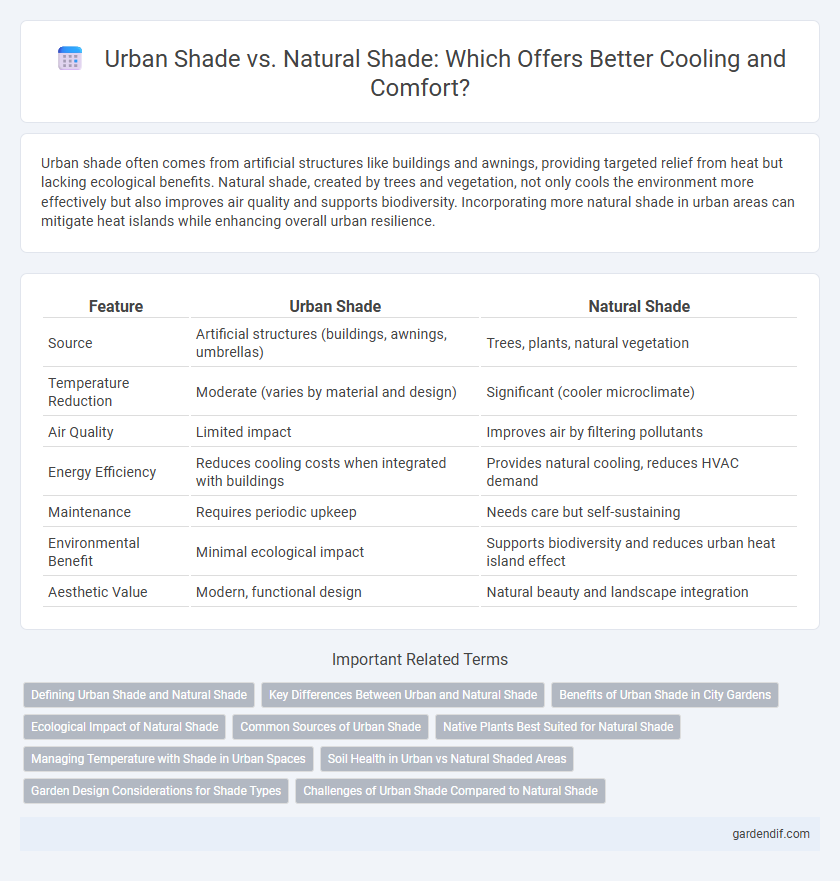
Urban Shade vs Natural Shade Illustration
Urban shade often comes from artificial structures like buildings and awnings, providing targeted relief from heat but lacking ecological benefits. Natural shade, created by trees and vegetation, not only cools the environment more effectively but also improves air quality and supports biodiversity. Incorporating more natural shade in urban areas can mitigate heat islands while enhancing overall urban resilience.
Table of Comparison
| Feature | Urban Shade | Natural Shade |
|---|---|---|
| Source | Artificial structures (buildings, awnings, umbrellas) | Trees, plants, natural vegetation |
| Temperature Reduction | Moderate (varies by material and design) | Significant (cooler microclimate) |
| Air Quality | Limited impact | Improves air by filtering pollutants |
| Energy Efficiency | Reduces cooling costs when integrated with buildings | Provides natural cooling, reduces HVAC demand |
| Maintenance | Requires periodic upkeep | Needs care but self-sustaining |
| Environmental Benefit | Minimal ecological impact | Supports biodiversity and reduces urban heat island effect |
| Aesthetic Value | Modern, functional design | Natural beauty and landscape integration |
Defining Urban Shade and Natural Shade
Urban shade consists of artificially created shade through structures like buildings, awnings, and street trees strategically planted to mitigate heat in city environments. Natural shade is provided by indigenous vegetation such as mature trees and dense foliage, offering ecological benefits like habitat creation and air purification. Both types contribute to cooling effects but differ in origin, biodiversity support, and environmental impact.
Key Differences Between Urban and Natural Shade
Urban shade primarily originates from man-made structures such as buildings, awnings, and street trees, often providing limited cooling effects due to reflective surfaces and heat retention. Natural shade is generated by dense tree canopies and vegetation, offering enhanced air purification, temperature regulation, and habitat support. The key differences lie in their environmental impact, cooling efficiency, and contribution to urban biodiversity.
Benefits of Urban Shade in City Gardens
Urban shade in city gardens significantly reduces ambient temperatures, mitigating the urban heat island effect and improving microclimate comfort for residents. It enhances air quality by filtering pollutants and providing oxygen through increased vegetation in densely built environments. Moreover, urban shade supports mental well-being by creating tranquil, green spaces that encourage outdoor activities and social interaction.
Ecological Impact of Natural Shade
Natural shade created by trees and vegetation significantly improves urban ecosystems by enhancing biodiversity and supporting local wildlife habitats. It reduces air pollution through carbon sequestration and lowers temperatures more effectively than artificial structures, mitigating the urban heat island effect. The ecological benefits of natural shade also include soil stabilization and increased water retention, which promote healthier urban environments.
Common Sources of Urban Shade
Urban shade primarily originates from man-made structures such as buildings, awnings, and pergolas that block direct sunlight, creating cooler microclimates in city environments. Street trees and urban parks supplement these structures by providing natural shade, although their coverage is often limited compared to rural areas. These combined elements help reduce urban heat islands, improve pedestrian comfort, and enhance energy efficiency in densely populated zones.
Native Plants Best Suited for Natural Shade
Native plants best suited for natural shade thrive under the dappled sunlight of dense tree canopies, offering ecological benefits and low maintenance. Species such as ferns, hostas, and wild ginger are ideal, as they adapt well to limited light and help preserve local biodiversity. These plants improve soil health and provide habitat for native wildlife, making them superior choices compared to artificial urban shade alternatives.
Managing Temperature with Shade in Urban Spaces
Urban shade, primarily created by strategically planted trees, green roofs, and architectural structures, significantly reduces surface temperatures and mitigates urban heat islands by blocking solar radiation and providing evapotranspiration cooling. Natural shade from mature forests maintains cooler microclimates through dense canopy cover and humidified air, offering more effective long-term temperature regulation. Effective management of urban shade involves selecting native, drought-tolerant vegetation and integrating shade elements into city planning to enhance thermal comfort and reduce energy consumption in urban environments.
Soil Health in Urban vs Natural Shaded Areas
Urban shade often results from artificial structures or non-native trees with limited root systems, leading to compacted soil and reduced microbial activity. Natural shade, provided by diverse native vegetation, promotes rich, aerated soils with higher organic matter content and enhanced microbial biodiversity. Consequently, soil health in naturally shaded areas supports better nutrient cycling and water retention compared to urban shaded environments.
Garden Design Considerations for Shade Types
Urban shade, created by buildings and artificial structures, often results in cooler microclimates but can limit sunlight for garden plants, affecting growth and health. Natural shade, produced by trees and vegetation, benefits garden ecosystems by providing filtered light, improving soil moisture retention, and supporting biodiversity. Garden design must consider the intensity, duration, and quality of shade to select appropriate plant species and ensure optimal growth conditions in both urban and natural settings.
Challenges of Urban Shade Compared to Natural Shade
Urban shade often faces challenges such as limited tree growth due to constrained soil volume and increased exposure to pollution, which can reduce leaf area and shade quality. Unlike natural shade, urban environments frequently contend with heat island effects, where concrete and asphalt surfaces trap heat, diminishing the cooling benefits of shade. These factors result in less effective temperature regulation and reduced ecological benefits compared to natural shade in forested or rural areas.
Urban Shade vs Natural Shade Infographic

 gardendif.com
gardendif.com